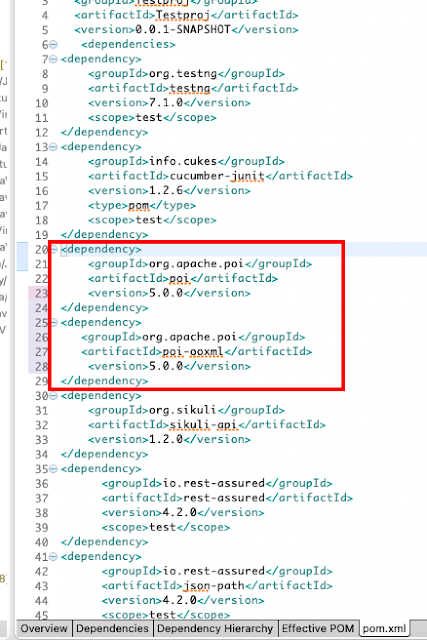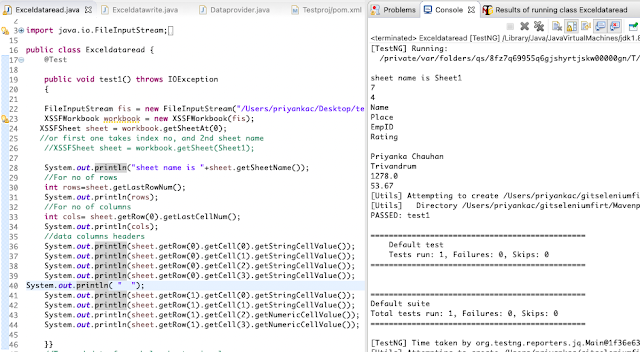Download files from Binary distribution .tar.gz for Mac and zip from windows, link
once all jar files are downloaded
Go to Java project-> right click-> Build Path-> configure Build path
Add external Jars
and click apply and OK
If you are using Maven add the Apache POI dependency in POM.XML
<dependency>
<groupId>org.apache.poi</groupId>
<artifactId>poi</artifactId>
<version>5.0.0</version>
</dependency>
<dependency>
<groupId>org.apache.poi</groupId>
<artifactId>poi-ooxml</artifactId>
<version>5.0.0</version>
</dependency>

public class Exceldataread {
@Test
public void test1() throws IOException
{
//"/Users/priyankac/Desktop/testdata.xlsx" is the path of the file which can be taken in Mac system by clicking on file-> Get Info-> copy the the path mentioned under "where" and paste it here, below is the screenshot for reference
//In windows while giving a path of the excel you need to convert forward slash into double backward slash
//In MAC you don't need to change anything
FileInputStream fis = new FileInputStream("/Users/priyankac/Desktop/testdata.xlsx");
XSSFWorkbook workbook = new XSSFWorkbook(fis);
//To fetch sheet with Index number
XSSFSheet sheet = workbook.getSheetAt(0);
//To fetch sheet with sheet name
//To fetch sheet name
//To fetch number of rows
int rows=sheet.getLastRowNum();
System.out.println(rows);
//To fetch number of coulmn
int cols= sheet.getRow(0).getLastCellNum();
System.out.println(cols);
//This is simple way To fetch all rows and columns present in the sheet including header
//Fetching the first row data
// Header Name O row and O column
System.out.println(sheet.getRow(0).getCell(0).getStringCellValue());
//Header place at 0 row 1st column
System.out.println(sheet.getRow(0).getCell(1).getStringCellValue());
//Header EmpID at 0 row 2nd column
System.out.println(sheet.getRow(0).getCell(2).getStringCellValue());
//Header Rating at 0 row 3rd column
System.out.println(sheet.getRow(0).getCell(3).getStringCellValue());
//Similarly we can fetch 2nd row data one by one
//Fetching data from 1st row and 0 column
System.out.println(sheet.getRow(1).getCell(0).getStringCellValue());
//Fetching data from 1st row and 1st column
System.out.println(sheet.getRow(1).getCell(1).getStringCellValue());
//Fetching data from 1st row and 2nd column
System.out.println(sheet.getRow(1).getCell(2).getRawValue());
//Fetching data from 1st row and 3rd column
System.out.println(sheet.getRow(1).getCell(3).getRawValue());
}}
//Similarly you can do it for the rest of rows.
If you want Result to be in in a line remove "ln" from print
Result
To Read all data in the sheet using "for loop"
public class Exceldataread {
@Test
public void test1() throws IOException
{
FileInputStream fis = new FileInputStream("/Users/priyankac/Desktop/testdata.xlsx");
XSSFWorkbook workbook = new XSSFWorkbook(fis);
XSSFSheet sheet = workbook.getSheetAt(0);
int rows=sheet.getLastRowNum();
System.out.println(rows);
int cols= sheet.getRow(0).getLastCellNum();
System.out.println(cols);
//Traversing through rows
for (int r=0;r<rows;r++)
{
XSSFRow row=sheet.getRow(r);
//Traversing through columns
for(int c=0;c<cols;c++)
{
XSSFCell cell=row.getCell(c);
//Switch is used to returns type of cell (string/numeric/boolean)
switch(cell.getCellType())
{
//Print command os used to stop same rows going in next line
case STRING: System.out.print(cell.getStringCellValue()); break;
case NUMERIC: System.out.print(cell.getNumericCellValue());break;
case BOOLEAN: System.out.print(cell.getBooleanCellValue());break;
}
// Pipe is used to create distance between 2 fields within a row
System.out.print(" | ");
}
//one row to another data should be written in next line
System.out.println();
}
}
}
public class Exceldataread {
@Test
public void test1() throws IOException
{
FileInputStream fis = new FileInputStream("/Users/priyankac/Desktop/testdata.xlsx");
XSSFWorkbook workbook = new XSSFWorkbook(fis);
XSSFSheet sheet = workbook.getSheetAt(0);
//Iterator object is created for sheet
while(it.hasNext())
{
//XSSF row typecasting should be used
XSSFRow row =(XSSFRow) it.next();
//Iterator should be applied on cell level
Iterator cellIt =row.cellIterator();
//To read all cells while loop is used
while(cellIt.hasNext())
{
XSSFCell cell=(XSSFCell) cellIt.next();
//Switch is used to returns type of cell (string/numeric/boolean)
switch(cell.getCellType())
{
case STRING: System.out.print(cell.getStringCellValue()); break;
case NUMERIC: System.out.print(cell.getNumericCellValue());break;
case BOOLEAN: System.out.print(cell.getBooleanCellValue());break;
}
// Pipe is used to create distance between 2 fields within a row
System.out.print(" | ");
}
//one row to another data should be written in next line
System.out.println();
}
}}












Comments
Post a Comment